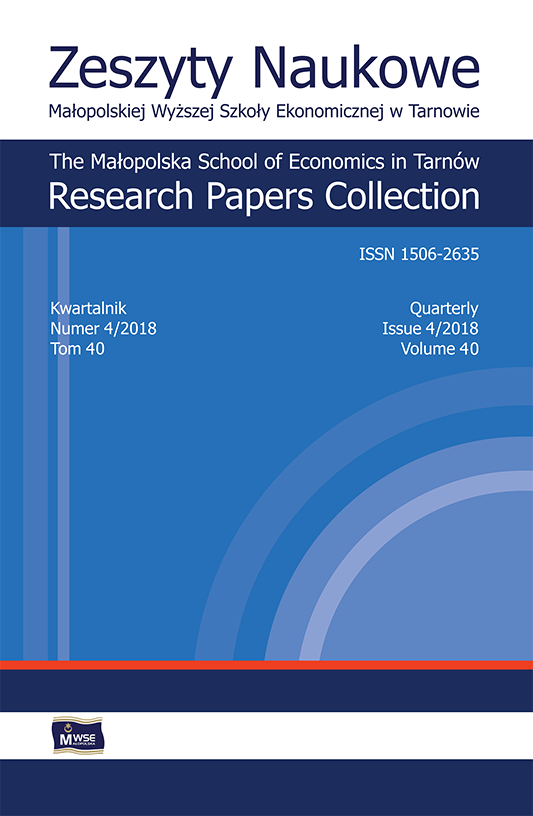Abstract
The aim of the article is to identify the reasons for the insufficient use of e-learning training in the SME sector and to indicate ways to reduce it, as well as to present the results of empirical research. The implementation of the foreseen objective was based on: analysis of the results of the predecessors’ researches and the questionnaire. Research, in its scope, included internal reasons for the low use of e-learning training, and so it related to the decision-making sphere of the company. Numerous financial, personnel and information barriers have been identified, as well as lack of a coherent training and knowledge management and poor cooperation with other entities in the sector. External causes derive, among others, from poor knowledge of the principles and methods of conducting cybernetic learning and communication, lack of interest and use of IT tools referred to as the ‘Internet of Things’, and finally low, unsatisfying work-life balance.
References
Bargij, J. (2014). Work-life balance, czyli balansowanie między pracą a życiem osobistym [online, accessed: 2016-02-15]. Ready for Future. Wrocław: Fundacja Educover. Retrieved from: http://educover.pl/czaspismo/work-life-balance-czyli-balansowanie-miedzy-praca-a-zyciem-osobistym/.
View in Google Scholar
Borkowska, S. (2004). Praca a życie pozazawodowe. In: S. Borkowska (ed.). Przyszłość pracy w XXI wieku. Warszawa: Instytut Pracy i Spraw Socjalnych. ISBN 838789057X.
View in Google Scholar
Brill, J. (2014). The Internet of things: Building trust and maximizing benefits through consumer control. Fordham Law Review, 83 (1), 205–217.
View in Google Scholar
Clutterbuck, D. (2005). Równowaga między życiem zawodowym a osobistym. Przewodnik dla specjalistów od spraw personalnych. Transl. by G. Łuczkiewicz. Kraków: Oficyna Ekonomiczna. ISBN 8389355515.
View in Google Scholar
Dąbrowska, A. (2014). Oddziaływania resocjalizacyjne. Autorski model pracy edukacyjno-wychowawczej z nieletnimi. Warszawa: Wydawnictwo Naukowe PWN. ISBN 9788301180003.
View in Google Scholar
Drath R., Horch A. (2014). Industrie 4.0: Hit or hype? IEEE Industrial Electronic Magazine, 8 (2), 56–58.
View in Google Scholar
Kienzler, I. (2003). Słownik terminologii komputerowej angielsko-polski i polsko-angielski. Gdynia: IVAX. ISBN 8388134116.
View in Google Scholar
Kot-Radojewska, M. (2014). Jak zachować równowagę? O work-life balance słów kilka [online, accessed: 2016-02-15]. In: Jobs.pl. Katowice: Jobs.pl SA. Retrieved from: www.jobs.pl/poradniki/jak-zachowac-rownowage-o-work-life-balance-slow-kilka.
View in Google Scholar
Kozioł, M. (2018). Wykorzystanie e-learningu w procesie szkolenia pracowników małych i średnich przedsiębiorstw. Pelplin: Bernardinum.
View in Google Scholar
López, T. S., Ranasinghe, D. C., Harrison M., McFarlane, D. (2012). Adding sense to the Internet of Things. Personal and Ubiquitous Computing, 16 (3), 291–308.
View in Google Scholar
Mącik, R. (2016). „Internet rzeczy” – postrzegane przez młodych konsumentów korzyści i zagrożenia – wyniki badań wstępnych. In: J. Moczydłowska, Z. Patora-Wysocka (eds.). Nowe trendy w zarządzaniu – perspektywa marketingowa i personalna (pp. 11–27). Przedsiębiorczość i Zarządzanie, 17 (4), part 3. Łódź–Warszawa: Wydawnictwo Społecznej Akademii Nauk.
View in Google Scholar
Monster Polska. (2016). Sukces to równowaga = balans między życiem zawodowym a osobistym [online, accessed: 2016-02-15]. Monster Polska. Retrieved from: http://informacje.monsterpolska.pl/sukces-to-rownowaga-balans-miedzy-zyciem-zawodowym-a-osobistym/article.aspx.
View in Google Scholar
Morgan, G. (ed.). (1983). Beyond method: Strategies for social research. Newbury Park: Sage Publications. ISBN 0803919735.
View in Google Scholar
OECD. (2018). Work-Life Balance [online, accessed: 2018-11-20]. In: OECD Better Life Index. Retrieved from: http://www.oecdbetterlifeindex.org/topics/work-life-balance/.
View in Google Scholar
Ożadowicz, A. (2014). Internet rzeczy w systemach automatyki budynkowej. Napędy i Sterowanie, 12, 88– 93.
View in Google Scholar
Samojlik, M. (2015). Work-life balance [online, accessed: 2016-02-15]. Elektroniczne Centrum Aktywizacji Młodzieży. Retrieved form: www.ecam.ohp.pl/-/work-life-balance-71323.
View in Google Scholar
Tchibo. (2015). Work-life balance: równowaga praca – rodzina [online, accessed: 2015-01-04]. Warszawa: Tchibo. Retrieved from: http://www.tchibo.com/content/1000076/-/pl/kariera/work-life-balance.html;jessionid=36DFFC364F41CDD1C050705D6C6BB5C.
View in Google Scholar
© Copyright by Małopolska School of Economics in Tarnów. The articles are available under the Creative Commons Attribution NonCommercial-NoDerivatives 4.0 International License


